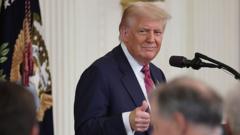As Trump pushes to dismantle the Department of Education, questions arise over its significance and the political hurdles he faces. The department, responsible for student loans and educational programs, can't be outright abolished without congressional consent, but Trump's administration aims for significant restructuring.
Trump’s Bold Move to Shut Down the Education Department: What Would It Mean?

Trump’s Bold Move to Shut Down the Education Department: What Would It Mean?
The President looks to make waves with an executive order targeting the Department of Education, but can he pull it off?
In a move that could redefine U.S. education policy, President Donald Trump is contemplating an executive order that would potentially dismantle the Department of Education, a long-standing ambition among conservative factions within the government. This initiative, as reported by multiple media sources, is a continuation of Trump's campaign promise to reduce federal oversight in education.
The proposed order would enable Trump to end certain programs within the department while reallocating some functions to other government sectors. Trump has tasked his newly appointed Education Secretary, Linda McMahon, with advancing the plan as far as permissible under existing laws, according to a draft reviewed by the Wall Street Journal. However, it is crucial to note that completely abolishing the Department of Education would necessitate congressional approval.
Founded in 1979, the Department of Education plays a vital role in U.S. education, overseeing public school funding, administering student loans, and implementing programs tailored to assist low-income students. Contrary to some common misunderstandings, the department does not directly control U.S. schools or their curricula; these are the prerogatives of local and state authorities. The agency also upholds civil rights laws to combat discrimination in federally funded educational institutions.
The budget for the Department of Education is a modest $238 billion for the fiscal year 2024, accounting for less than 2% of the federal budget, and it boasts around 4,400 employees, the smallest workforce among cabinet-level departments. State and local governments provide most funding for U.S. schools, with an estimated total expenditure of over $857 billion on primary and secondary education in 2024.
While Trump is eager to reduce the department's influence, his efforts to eliminate it face significant challenges. Not only would he require a supermajority in the Senate—60 of 100 votes—to abolish the agency, but he would also likely encounter resistance within the House of Representatives. A previous attempt to abolish the education department failed, with a substantial number of Republicans opposing it alongside Democratic votes.
Trump's efforts to streamline government have raised questions about the legality and feasibility of his plans. Even a draft of the executive order recognized Congress's authority in terminating the department, suggesting that any executive action may merely initiate a winding-down process rather than an outright elimination.
The push to eliminate the Department of Education has historical roots within the Republican Party, dating back to the Reagan administration in the 1980s. There is a long-standing belief among conservatives that educational governance should reside at the state and local level rather than under federal control. Contemporary arguments against the department often center on perceptions of it promoting what critics label as "woke" ideologies regarding race and gender among school curricula. Additionally, advocates for school choice seek to redirect educational funding in a way that allows families to select alternatives to public schooling.
As the nation watches, the outcome of Trump's initiative could have profound implications for the future of education policy in America, intersecting with broader discussions on federalism, civil rights, and family choice in education.





















